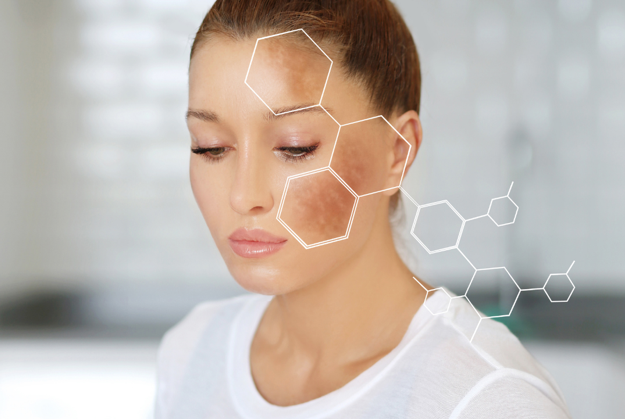|
Tune in to any latest fashion show and you’ll most likely see the humble face mask standing proud and centre of any collection. Once only reserved as hot couture from the hospital hallway, they now can be seen on the runway from Gucci to Dior and beyond, as the pandemic has seemingly modified the mask into the latest must have trend. However, not all masks can be considered as stylish. Melasma, otherwise referred to as the ‘pregnancy mask’ is a very common skin condition that effects many people around the world and is something that makes us feel not so much like a supermodel. Melasma is a type of hyperpigmentation that causes blotchy, brown patches on the face generally in a larger symmetrical pattern on the forehead, cheeks, upper lip and chin, and this symmetry is normally what distinguishes melasma from other pigmentation concerns. Thinking about melasma always makes me think of those ink blotch charts psychiatrists sometimes show to patients in therapy asking them to “tell me what you see?” I’m not really sure if this is a real thing that medical professionals do, or something just from the movies but melasma really does have a similar symmetrical pattern. Even though melasma is so common, we’re still unsure of what actually causes it to appear. While the why is still to be determined, what we do know is how it appears. Melasma or any kind of hyperpigmentation on the skin is formed when the cells responsible for producing the skin’s pigment, the melanocyte cells, become over excited thereby producing an excess amount of pigment. This process is similar to what causes brown age spots and freckles, but melasma patches tend to be larger, more noticeable and symmetrical. Those with a darker skin tone are also more prone to developing melasma or any hyperpigmentation condition as they have more pigment than those with a lighter tone and their pigment producing cells tend to be more easily stimulated. There are many theories as to what causes melasma but one of the most plausible is that it has some kind of hormonal stimulation. It can also be worsened by UV exposure, and so the sun also seems to contribute to its formation. Melasma is more common in women than men yet they can be affected by it too, but it appears a larger percentage of the time during or after pregnancy supporting this theory of a hormonal link and giving melasma its nickname of ‘the pregnancy mask.’ "It's not only associated with pregnancy, but can affect women at all stages of life," says Dr. Shadi Kourosh, director of the Pigmentary Disorder and Multi-Ethnic Skin Clinic at Harvard-affiliated Massachusetts General Hospital. And once melasma forms, it can be very stubborn to treat, often resisting treatments and possibly sticking around for years. This is due to the fact that melasma can have pigment sitting lower in the dermis or lower layers of the skin in comparison to other forms of hyperpigmentation, which may be more superficial. Dr. Barbara Gilchrest, senior lecturer on dermatology at Harvard Medical School describes that, "Women who develop melasma in their teens or 20s or 30s may see it stay around for decades." Melasma can also be stimulated by other sources such as UV exposure, medications, and topical products which may irritate the skin or cause it to be more sun sensitive. This condition can also be a little more clingy than other forms of hyperpigmentation and can often return to patients once it has been removed due to re-stimulation from other factors previously mentioned. So how on earth do we get rid of it? If it affects so many of us surely there has to be a cure, right? Well luckily there are some things that we can do to not only reduce melasma but also minimise its chances of returning. While IPL claims and evidently does reduce pigmentation, it can be tempting to book in for a zap and be done with it. But unfortunately, IPL is generally seen as a temporary result since it doesn’t address the pigmentation process itself and so the melasma usually returns again sometime in the future. Success can also be varied as melasma tends to also sit deeper in the skin than other types of pigmentation, and so it can be tricky for the IPL machine to successfully treat the pigment depending on the wave lengths used and where the pigment is located. The best way to treat any hyperpigmentation not only melasma, is with a combination of therapies that work not only treat the pigment and get rid of it but also stop it from being produced or returning in the future. This process may take much commitment over months and multiple treatments to yield results, however we must remember the 5 P’s to great skin results and that nothing to do with skin happens overnight especially when a condition has taken multiple years to form in the first place. By the use of topical homecare products such as Ultraceuticals MD brightening range or prescription creams such as Kligman’s Formula from the doctor in conjunction with treatments within the clinic such as skin needling or brightening peels, we can successfully reduce the appearance of melasma. Cosmelan, a treatment which acts as a depigmenting mask is also a great option for those who can afford the downtime, as it offers significantly quicker results but still requires much commitment and religious application of homecare products. Also, avoiding the sun as much as possible during and after treatment will help to minimise the risk of melasma worsening or reoccurring. At the end of the day, melasma remains one of the most common yet stubborn skin conditions to treat but with the right products, patience and persistence we can effectively reduce it. https://www.health.harvard.edu/womens-health/unmasking-the-causes-and-treatments-of-melasma https://www.centraldermatologyclinic.com.au/melasma/ - Skin x
0 Comments
Leave a Reply. |
Archives
June 2023
Categories |
SKIN GERALDTON |
QUICK LINKS |




 RSS Feed
RSS Feed

